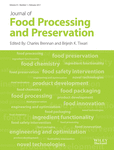The Effects of Technological Parameters on Chicken Meat Osmotic Dehydration Process Efficiency
Abstract
Osmotic dehydration is important food preservation method because of many advantages considering mild processing temperature, base waste material and low energy requirements. The goal of this research was to investigate the effects of the process temperaute, time and osmotic solution concentration on the effectiveness of the chicken meat osmotic dehydration process in osmotic solution of sodium сhloride and sucrose. Developed mathematical models had good fit with experimental data, while maximal obtained values of process responses of: dry matter content: 58.30 ± 0.22%; water loss: 0.4791 ± 0.0014 g/gi.s.; solid gain: 0.1579 ± 0.0024 g/gi.s. and water activity: 0.800 ± 0.001; indicated on good dehydration levels and that applied osmotic solution is very good osmotic medium. Application of principal component analysis has provided better visualization in differentiation of the samples, while score analysis was used to point at optimal combination of technological parameters in effort to obtain best osmotic dehydration process results.
Practical Applications
Process of osmotic dehydration is commonly used technique for food processing since its low energy requirements for water removal, minimal waste material and possibility of producing new types of food products from animal and plant raw matterials. This study investigates the effects of applied technological parameters on the process of osmotic dehydration of chicken meat. Developed mathematical models in this research can be considered as precise for process parameters prediction and optimization in experimental and industrial applications. The analysis of the osmotic dehydration process efficiency points at the optimal combination of applied technological parameters in effort to obtain best osmotic dehydration process results.




